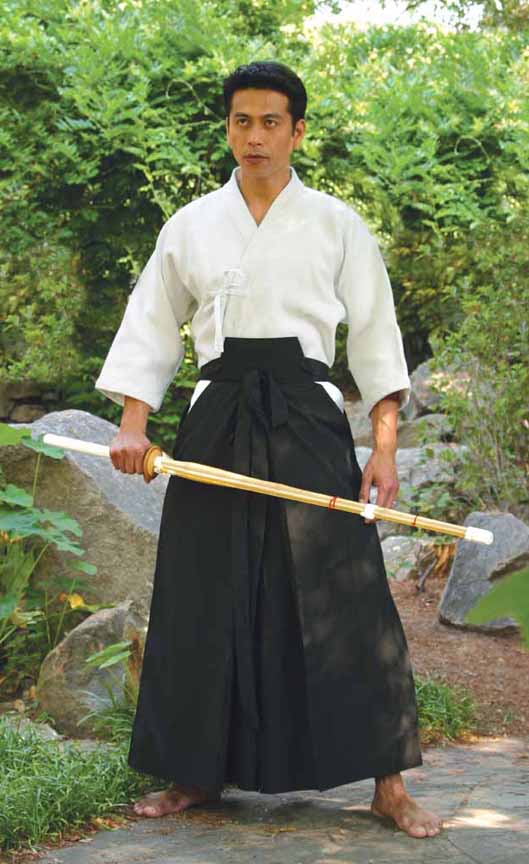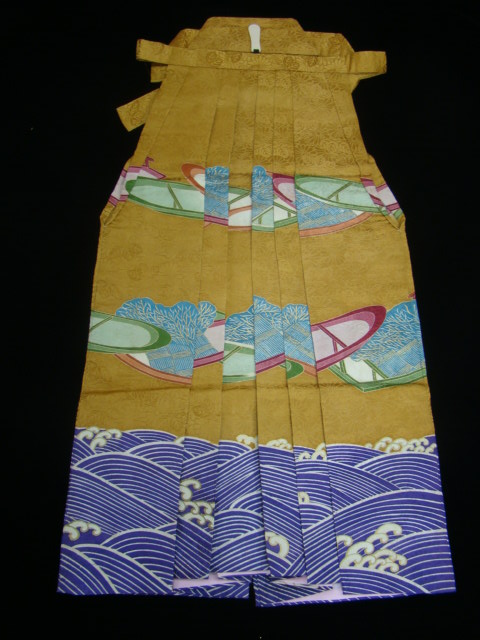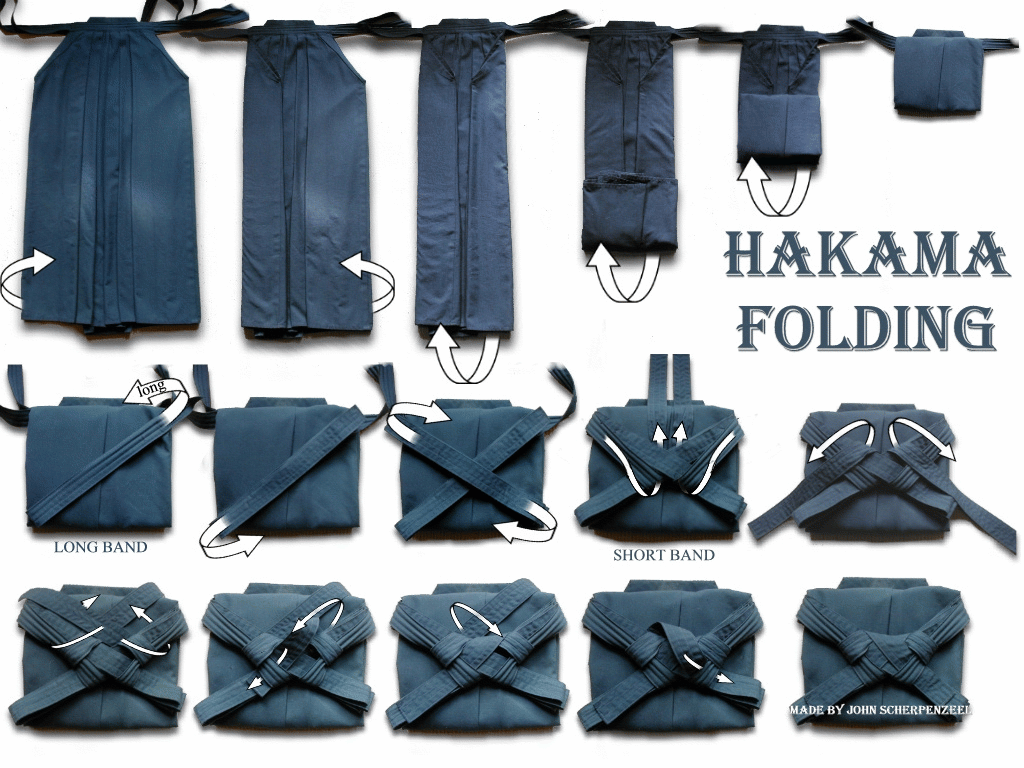Difference between revisions of "Hakama"
Weird Bird (talk | contribs) m |
|||
| (9 intermediate revisions by 4 users not shown) | |||
| Line 1: | Line 1: | ||
| + | {{cleanup | ||
| + | |reason=Some information is copied directly from an external site | ||
| + | |date=March 2024 | ||
| + | }} | ||
| + | |||
[[Image:Hakama example.jpg|thumb|Kendo practitioner in traditional clothing]] | [[Image:Hakama example.jpg|thumb|Kendo practitioner in traditional clothing]] | ||
| − | Hakama | + | '''Hakama''' are a type of traditional [[Japanese]] [[trousers]]. They were originally worn only by men, but today they are worn by both men and women. Hakama are tied at the waist and fall approximately to the ankles. Hakama are worn over a [[kimono]]. |
| − | There are two types of hakama | + | |
| + | ===In history=== | ||
| + | Hakama traditionally formed part of a complete outfit called a kamishimo, worn by samurai and courtiers during the Edo period. The outfit included a formal [[kimono]], hakama, and a sleeveless jacket with exaggerated shoulders called a kataginu Some hakama had small armor plates or mail armor sewn to the cloth of the hakama, to be worn by samurai warriors. | ||
| + | |||
| + | While men's hakama can be worn on both formal and informal occasions, women rarely wear hakama, except at graduation ceremonies and for traditional Japanese sports such as kyudo, some branches of aikido and kendo. Hakama are also part of the every-day wear of Shinto kannushi, priests who maintain and perform services at shrines. | ||
| + | |||
| + | Formal hakama are worn with black montsuki kimono (kimono with one, three, or five family crests on the back, chest, and shoulders), white [[tabi]] (divided-toe socks), white naga-juban (under-kimono) and various types of footwear. In cooler weather, a [[montsuki haori]] (long jacket) with a white haori-himo (haori-fastener) completes the outfit. Hakama can be worn with any type of kimono except yukata (light cotton summer kimono generally worn for relaxing, for sleeping, or at festivals or summer outings). | ||
| + | |||
| + | ===In Amtgard=== | ||
| + | Some Amtgardians prefer hakama over other forms of leg covering. For some, the wide legs are ideal for ease of movement during combat. For others, hakama fit better with their persona's visual aspects. | ||
| + | |||
| + | ===Making hakama=== | ||
| + | [[Image:Hakama.JPG|thumb|historical example of highly decorated Hakama, from the 17th century]] | ||
| + | There are two types of hakama: divided (umanori, "horse-riding" hakama) and undivided (andon bakama). The umanori type have divided legs, though both of these types appear similar. A "mountain" or "field" type of umanori hakama were traditionally worn by field or forest workers. They are looser in the waist and narrower in the leg. | ||
| − | |||
| − | |||
[[Image:Hakamafolding.png|left|thumb|How to traditionally fold and store you Hakama]] | [[Image:Hakamafolding.png|left|thumb|How to traditionally fold and store you Hakama]] | ||
| − | + | Hakama are secured by four straps; two longer himo attached on either side of the front of the garment, and two shorter himo attached on either side of the rear. The rear of the garment has a rigid board-like section, called koshi-ate, below that is a hakama-dome (a spoon shaped component) which is tucked into the obi or himo at the rear, and helps to keep the hakama in place. | |
| − | Hakama | + | |
| + | Hakama have seven deep pleats, two on the back and five on the front. The pleats are said to represent the seven virtues of bushido, considered essential the samurai way. Although they appear balanced, the arrangement of the front pleats, (three to the right, two to the left) is asymmetrical. | ||
| − | + | ====Materials==== | |
| + | The most formal type of men's hakama are made of stiff, striped [[silk]], usually black and white, or black and navy blue. While striped hakama are usually worn with formal kimono, stripes in colours other than black, grey and white may be worn with less formal wear. Solid and gradated colors are also common. | ||
| − | In | + | In Amtgard, fabrics made of [[cotton]] and [[linen]] are often used in replacement of silk. |
| − | |||
| − | |||
| − | |||
| − | |||
| − | |||
| − | |||
===Links=== | ===Links=== | ||
| − | *[http://www. | + | *[http://roundearth.stores.yahoo.net/hakformarar.html Hakama Information] and instruction |
| − | *[http://www. | + | *[http://www.alonatwotrees.com/library/howto/hakama.pdf Hakama Tutorial] by [[Alona]] |
| + | *[https://web.archive.org/web/20060202094108/http://www.sengokudaimyo.com/katchu/graphics/patterns/hakama1.PDF Pattern] with instructions and a diagram | ||
| + | |||
[[Category:Garb]] [[Category:Amtgard Things]] [[category:Amtgard Resources]] | [[Category:Garb]] [[Category:Amtgard Things]] [[category:Amtgard Resources]] | ||
| + | [[Category:Japanese Garb]] [[Category:Garb Bottoms]] | ||
Latest revision as of 21:32, 12 March 2024
| This article may require cleanup. The specific problem is: Some information is copied directly from an external site. Relevant discussion may be found on the talk page. Please help improve this article if you can. (March 2024) |
Hakama are a type of traditional Japanese trousers. They were originally worn only by men, but today they are worn by both men and women. Hakama are tied at the waist and fall approximately to the ankles. Hakama are worn over a kimono.
In history
Hakama traditionally formed part of a complete outfit called a kamishimo, worn by samurai and courtiers during the Edo period. The outfit included a formal kimono, hakama, and a sleeveless jacket with exaggerated shoulders called a kataginu Some hakama had small armor plates or mail armor sewn to the cloth of the hakama, to be worn by samurai warriors.
While men's hakama can be worn on both formal and informal occasions, women rarely wear hakama, except at graduation ceremonies and for traditional Japanese sports such as kyudo, some branches of aikido and kendo. Hakama are also part of the every-day wear of Shinto kannushi, priests who maintain and perform services at shrines.
Formal hakama are worn with black montsuki kimono (kimono with one, three, or five family crests on the back, chest, and shoulders), white tabi (divided-toe socks), white naga-juban (under-kimono) and various types of footwear. In cooler weather, a montsuki haori (long jacket) with a white haori-himo (haori-fastener) completes the outfit. Hakama can be worn with any type of kimono except yukata (light cotton summer kimono generally worn for relaxing, for sleeping, or at festivals or summer outings).
In Amtgard
Some Amtgardians prefer hakama over other forms of leg covering. For some, the wide legs are ideal for ease of movement during combat. For others, hakama fit better with their persona's visual aspects.
Making hakama
There are two types of hakama: divided (umanori, "horse-riding" hakama) and undivided (andon bakama). The umanori type have divided legs, though both of these types appear similar. A "mountain" or "field" type of umanori hakama were traditionally worn by field or forest workers. They are looser in the waist and narrower in the leg.
Hakama are secured by four straps; two longer himo attached on either side of the front of the garment, and two shorter himo attached on either side of the rear. The rear of the garment has a rigid board-like section, called koshi-ate, below that is a hakama-dome (a spoon shaped component) which is tucked into the obi or himo at the rear, and helps to keep the hakama in place.
Hakama have seven deep pleats, two on the back and five on the front. The pleats are said to represent the seven virtues of bushido, considered essential the samurai way. Although they appear balanced, the arrangement of the front pleats, (three to the right, two to the left) is asymmetrical.
Materials
The most formal type of men's hakama are made of stiff, striped silk, usually black and white, or black and navy blue. While striped hakama are usually worn with formal kimono, stripes in colours other than black, grey and white may be worn with less formal wear. Solid and gradated colors are also common.
In Amtgard, fabrics made of cotton and linen are often used in replacement of silk.
Links
- Hakama Information and instruction
- Hakama Tutorial by Alona
- Pattern with instructions and a diagram


